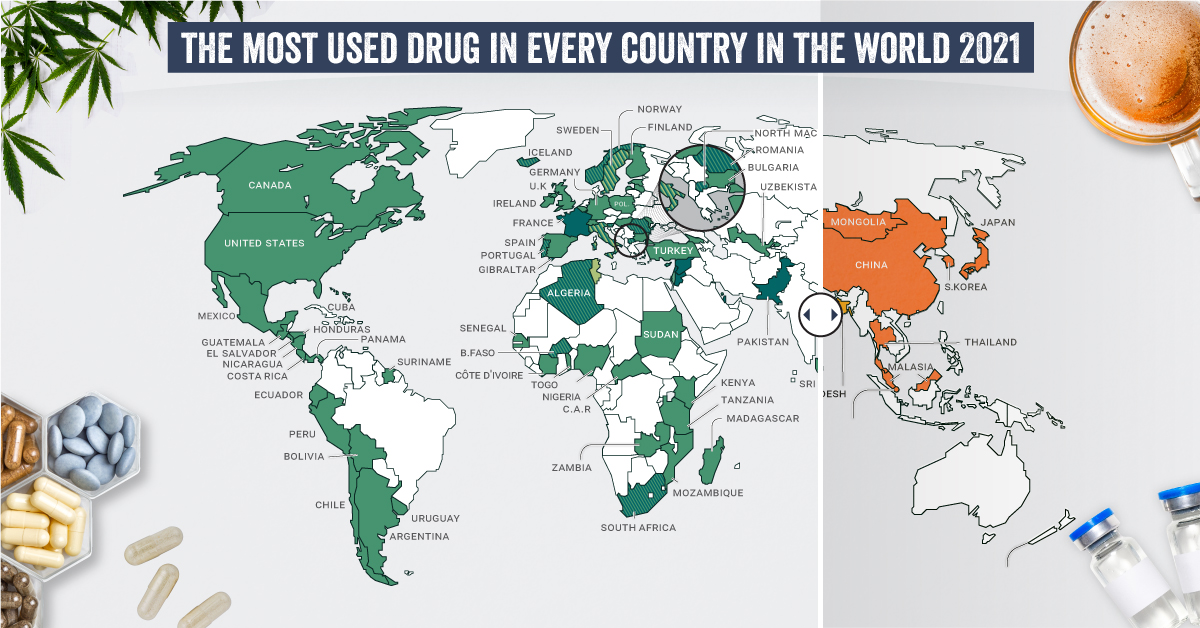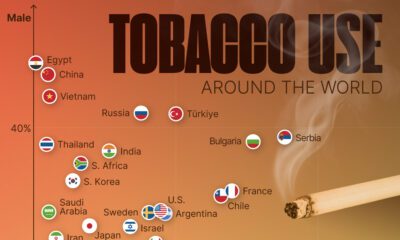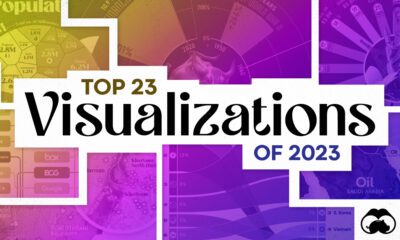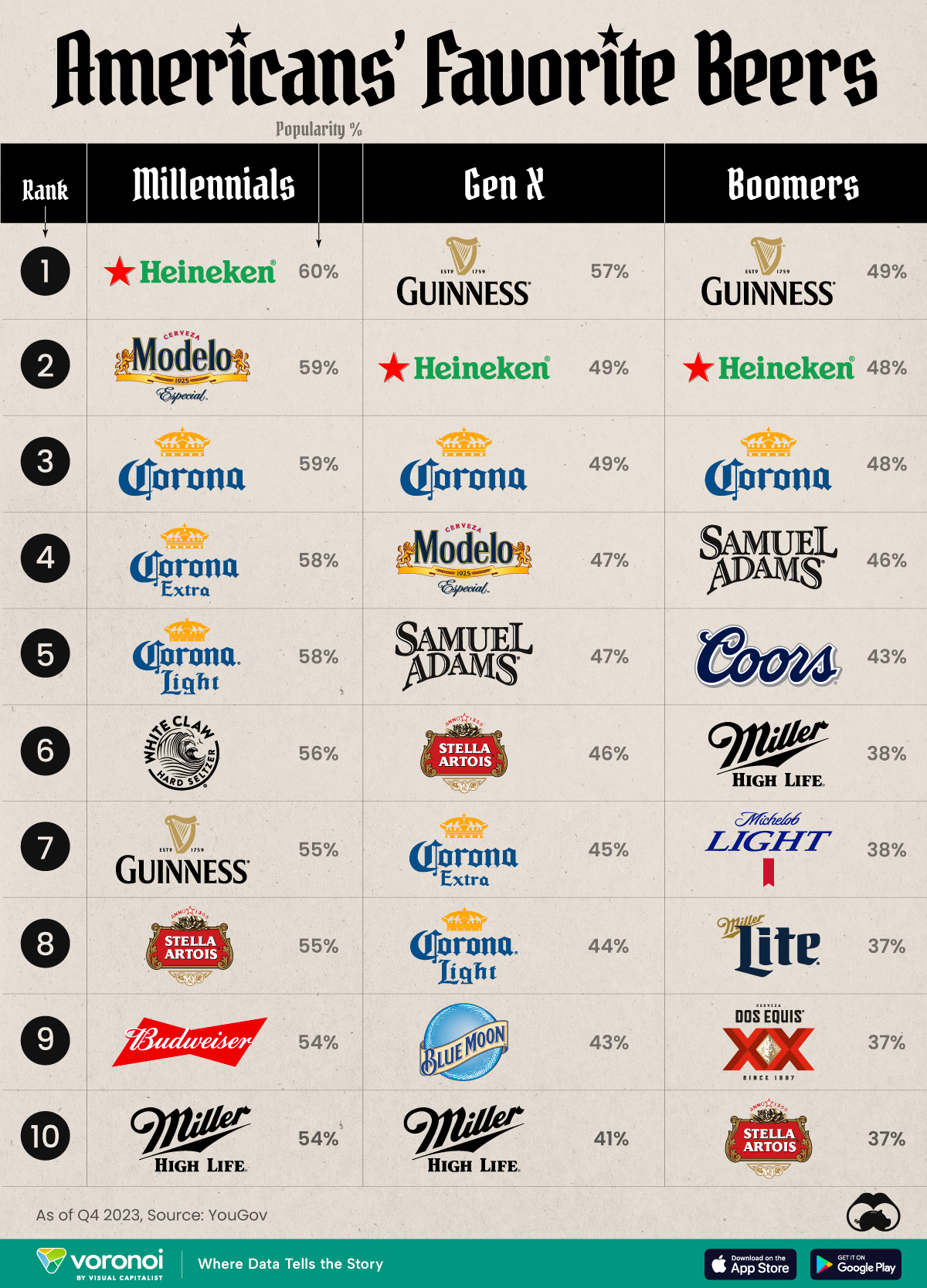Culture
Mapped: The Most Common Illicit Drugs in the World
How to Use: The below maps will transition automatically. To pause, move your cursor on the image. Arrows on left/right navigate.
Mapped: The Most Common Illicit Drugs in the World
Despite strict prohibitory laws around much of the world, many common illicit drugs still see widespread use.
Humans have a storied and complicated relationship with drugs. Defined as chemical substances that cause a change in our physiology or psychology, many drugs are taken medicinally or accepted culturally, like caffeine, nicotine, and alcohol.
But many drugs—including medicines and non-medicinal substances taken as drugs—are taken recreationally and can be abused. Each country and people have their own relationship to drugs, with some embracing the use of specific substances while others shun them outright.
What are the most common drugs that are considered generally illicit in different parts of the world? Today’s graphics use data from the UN’s World Drug Report 2021 to highlight the most prevalent drug used in each country.
What Types of Common Drugs Are Tracked?
The World Drug Report looks explicitly at the supply and demand of the international illegal drug market, not including commonly legal substances like caffeine and alcohol.
Drugs are grouped by class and type, with six main types of drugs found as the most prevalent drugs worldwide.
- Cannabis*: Drugs derived from cannabis, including hemp. This category includes marijuana (dried flowers), hashish (resin), and other for various other parts of the plant or derived oils.
- Cocaine: Drugs derived from the leaves of coca plants. Labeled as either cocaine salts for powder form or crack for cocaine processed with baking soda and water into rock form.
- Opioids: Includes opiates which are derived directly from the opium poppy plant, including morphine, codeine, and heroin, as well as synthetic alkaloids.
- Amphetamine-type Stimulants (ATS): Amphetamine and drugs derived from amphetamine, including meth (also known as speed), MDMA, and ecstasy.
- Sedatives and Tranquilizers: Includes other drugs whose main purpose is to reduce energy, excitement, or anxiety, as well as drugs used primarily to initiate or help with sleep (also called hypnotics).
- Solvents and Inhalants: Gases or chemicals that can cause intoxication but are not intended to be drugs, including fuels, glues, and other industrial substances.
The report also tracked the prevalence of hallucinogens—psychoactive drugs which strongly affect the mind and cause a “trip”—but no hallucinogens ranked as the most prevalent drug in any one country.
*Editor’s note: Recreational cannabis is legal in five countries, and some non-federal jurisdictions (i.e. states). However, in the context of this report, it was included because it is still widely illicit in most countries globally.
The Most Prevalent Drug in Each Country
According to the report, 275 million people used drugs worldwide in 2020. Between the ages of 15–64, around 5.5% of the global population used drugs at least once.
Many countries grouped different types of the same drug class together, and a few like Saudi Arabia and North Macedonia had multiple different drug types listed as the most prevalent.
But across the board, cannabis was the most commonly prevalent drug used in 107 listed countries and territories:
| Country or territory | Most Prevalent Drug(s) |
|---|---|
| Afghanistan | Heroin, opium |
| Albania | Sedatives and tranquillizers (general) |
| Algeria | Cannabis (general) |
| Argentina | Cannabis (herb) |
| Australia | Cannabis (general) |
| Azerbaijan | Heroin |
| Bahamas | Cannabis (herb) |
| Bahrain | Cannabis (general) |
| Bangladesh | Amphetamine |
| Belarus | Opium |
| Belgium | Cannabis (herb) |
| Bolivia | Cannabis (herb) |
| Brunei | Cannabis (herb) |
| Bulgaria | Cannabis (herb) |
| Burkina Faso | Cannabis (general) |
| Canada | Cannabis (herb) |
| Central African Republic | Cannabis (herb) |
| Chile | Cannabis (herb) |
| China | Methamphetamine |
| Costa Rica | Cannabis (herb) |
| Côte d'Ivoire | Cannabis (herb) |
| Croatia | Heroin |
| Cyprus | Cannabis (general) |
| Czech Republic | Benzodiazepines |
| Dominican Republic | Cocaine (powder) |
| Ecuador | Cannabis (herb) |
| El Salvador | Cannabis (herb) |
| Estonia | Cannabis (herb) |
| Finland | Cannabis (herb) |
| France | Cannabis (hashish) |
| Georgia | Cannabis (herb) |
| Germany | Cannabis (herb) |
| Gibraltar | Cannabis (hashish) |
| Greece | Solvents and inhalants (general) |
| Guatemala | Cannabis (herb) |
| Honduras | Cannabis (herb) |
| Hong Kong | Heroin, opium, opioids |
| Hungary | Cannabis (herb) |
| Iceland | Cannabis (general) |
| India | Heroin |
| Indonesia | Cannabis (herb) |
| Iran | Opium |
| Ireland | Cannabis (herb) |
| Israel | Cannabis (herb) |
| Italy | Cannabis (general) |
| Japan | Methamphetamine |
| Jordan | Cannabis (hashish) |
| Kenya | Cannabis (herb) |
| Latvia | Cannabis (herb) |
| Lebanon | Cannabis (hashish) |
| Liechtenstein | Cannabis (hashish) |
| Lithuania | Sedatives and tranquillizers (general) |
| Luxembourg | Cannabis (general) |
| Macao | Methamphetamine |
| Madagascar | Cannabis (herb) |
| Malaysia | Methamphetamine |
| Malta | Heroin |
| Mexico | Cannabis (herb) |
| Moldova | Cannabis (herb) |
| Mongolia | Methamphetamine |
| Mozambique | Cannabis (herb) |
| Myanmar | Heroin |
| Netherlands | Benzodiazepines |
| New Zealand | Methamphetamine, solvent and inhalants |
| Nicaragua | Cannabis (herb) |
| Nigeria | Cannabis (herb) |
| North Macedonia | Multiple types |
| Norway | Cannabis (general) |
| Oman | Opium |
| Pakistan | Cannabis (hashish) |
| Panama | Cannabis (herb) |
| Peru | Cannabis (herb) |
| Philippines | Cannabis (herb) |
| Poland | Cannabis (herb) |
| Portugal | Cannabis (general) |
| Qatar | Cannabis (hashish) |
| Romania | Cannabis (general) |
| Saudi Arabia | Multiple types |
| Senegal | Cannabis (herb) |
| Serbia | Benzodiazepines |
| Singapore | Methamphetamine |
| Slovenia | Cannabis (general) |
| South Africa | Cannabis (general) |
| South Korea | Methamphetamine |
| Spain | Cannabis (herb) |
| Sri Lanka | Cannabis (herb) |
| Sudan | Cannabis (herb) |
| Suriname | Cannabis (herb) |
| Sweden | Cannabis (general) |
| Switzerland | Cannabis (herb) |
| Syrian Arab Republic | Cannabis (hashish) |
| Tajikistan | Heroin, opium |
| Tanzania | Cannabis (herb) |
| Thailand | Methamphetamine |
| Togo | Cannabis (herb) |
| Trinidad and Tobago | Cocaine (crack) |
| Tunisia | Cannabis (general) |
| Turkey | Cannabis (herb) |
| Turkmenistan | Opium |
| U.S. | Cannabis (herb) |
| UK | Cannabis (herb) |
| Ukraine | Opioids |
| Uruguay | Cannabis (herb) |
| Uzbekistan | Cannabis (herb) |
| Venezuela | Benzodiazepines |
| Vietnam | Heroin |
| Zambia | Cannabis (herb) |
How prevalent is cannabis worldwide? 72 locations or more than two-thirds of those reporting listed cannabis as the most prevalent drug.
Unsurprisingly these include countries that have legalized recreational cannabis: Canada, Georgia, Mexico, South Africa, and Uruguay.
How Common Are Opioids and Other Drugs?
Though the global prevalence of cannabis is unsurprising, especially as it becomes legalized and accepted in more countries, other drugs also have strong footholds.
Opioids (14 locations) were the most prevalent drugs in the Middle-East, South and Central Asia, including in India and Iran. Notably, Afghanistan is the world’s largest producer of opium, supplying more than 90% of illicit heroin globally.
Amphetamine-type drugs (9 locations) were the third-most common drugs overall, mainly in East Asia. Methamphetamine was the reported most prevalent drug in China, South Korea, and Japan, while amphetamine was only the most common drug in Bangladesh.
However, it’s important to note that illicit drug usage is tough to track. Asian countries where cannabis is less frequently found (or reported) might understate its usage. At the same time, the opioid epidemic in the U.S. and Canada reflects high opioid usage in the West.
As some drugs become more widespread and others face a renewed “war,” the landscape is certain to shift over the next few years.
Culture
Ranked: America’s Most Popular Beers, by Generation
We visualize the results of a YouGov survey that determined the most popular beers among each U.S. generation.
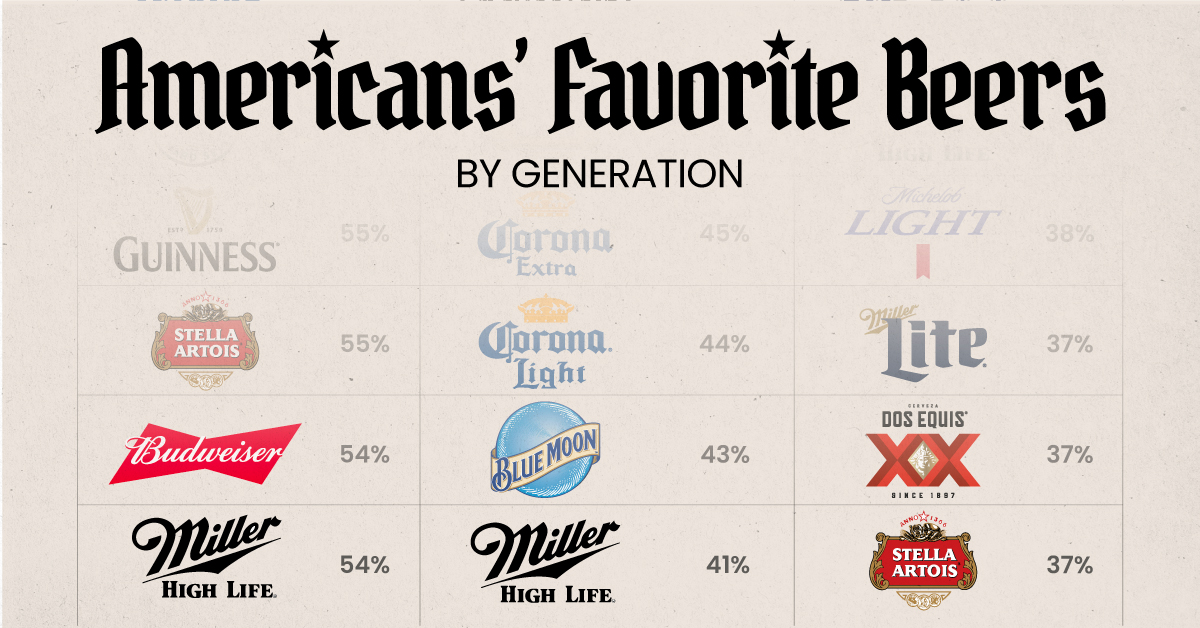
America’s Most Popular Beers, by Generation
This was originally posted on our Voronoi app. Download the app for free on iOS or Android and discover incredible data-driven charts from a variety of trusted sources.
In this graphic we’ve visualized the most popular beers for each U.S. generation as of Q4 2023, according to a consumer survey conducted by YouGov.
The “popularity” metric represents the % of people who had a positive opinion of that beer. Note that YouGov surveys are conducted with a representative sample of 1,500 respondents.
Overview: Millennials
U.S. millennials appear to favor foreign beers, with the top five spots taken by Dutch (Heineken) or Mexican beers (Modelo, Corona).
| Beer | Popularity (%) |
|---|---|
| 🇳🇱 Heineken | 60 |
| 🇲🇽 Modelo | 59 |
| 🇲🇽 Corona | 59 |
| 🇲🇽 Corona Extra | 58 |
| 🇲🇽 Corona Light | 58 |
| 🇺🇸 White Claw | 56 |
| 🇮🇪 Guinness | 55 |
| 🇧🇪 Stella Artois | 55 |
| 🇺🇸 Budweiser | 54 |
| 🇺🇸 Miller | 54 |
While not exactly a beer, White Claws (which have a similar alcohol content) claimed sixth place. Hard seltzers have become very popular in recent years due to their variety of flavors, attractive packaging, and relatively low amount of carbs and calories.
Overview: Gen X
Gen X also has a strong preference for foreign beers, particularly Guinness (fun fact: Over 31 million Americans claim to be of Irish descent).
| Beer | Popularity (%) |
|---|---|
| 🇮🇪 Guinness | 57 |
| 🇳🇱 Heineken | 49 |
| 🇲🇽 Corona | 49 |
| 🇲🇽 Modelo | 47 |
| 🇺🇸 Samuel Adams | 47 |
| 🇧🇪 Stella Artois | 46 |
| 🇲🇽 Corona Extra | 45 |
| 🇲🇽 Corona Light | 44 |
| 🇺🇸 Blue Moon | 43 |
| 🇺🇸 Miller | 41 |
Two American beers that weren’t on Millennials’ top 10 list are Samuel Adams and Blue Moon.
Samuel Adams is the flagship brand of the Boston Beer Company, named after U.S. Founding Father Samuel Adams. On the other hand, Blue Moon is a Belgian-style witbier brewed by Molson Coors.
Overview: Baby Boomers
Boomers’ top 10 favorite beers are similar to Gen X, with a few key differences. One is the absence of Modelo, which ranked second and fourth for Millennials and Gen X, respectively.
Modelo (which became America’s best-selling beer in 2023) has focused its advertising efforts on sports, which may not reach Boomers as effectively as younger generations.
| Beer | Popularity (%) |
|---|---|
| 🇮🇪 Guinness | 49 |
| 🇳🇱 Heineken | 48 |
| 🇲🇽 Corona | 48 |
| 🇺🇸 Samuel Adams | 46 |
| 🇺🇸 Coors | 43 |
| 🇺🇸 Miller | 38 |
| 🇺🇸 Michelob Light | 38 |
| 🇺🇸 Miller Lite | 37 |
| 🇲🇽 Dos Equis | 37 |
| 🇧🇪 Stella Artois | 37 |
An interesting pick for Boomers is Dos Equis, which is produced by Heineken-owned Cuauhtémoc Moctezuma Brewery. The brand gained popularity for its “most interesting man in the world” commercials, which ran from 2006 to 2018.
See More Beer Graphics 🍺
Be sure to check out this graphic which breaks down global beer consumption by country.
-

 Maps2 weeks ago
Maps2 weeks agoMapped: Average Wages Across Europe
-

 Money1 week ago
Money1 week agoWhich States Have the Highest Minimum Wage in America?
-

 Real Estate1 week ago
Real Estate1 week agoRanked: The Most Valuable Housing Markets in America
-

 Markets1 week ago
Markets1 week agoCharted: Big Four Market Share by S&P 500 Audits
-

 AI1 week ago
AI1 week agoThe Stock Performance of U.S. Chipmakers So Far in 2024
-

 Automotive2 weeks ago
Automotive2 weeks agoAlmost Every EV Stock is Down After Q1 2024
-

 Money2 weeks ago
Money2 weeks agoWhere Does One U.S. Tax Dollar Go?
-

 Green2 weeks ago
Green2 weeks agoRanked: Top Countries by Total Forest Loss Since 2001





